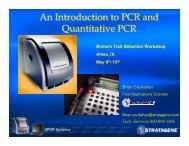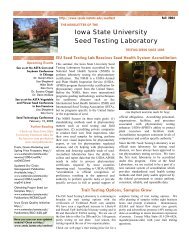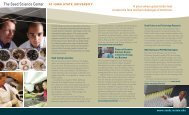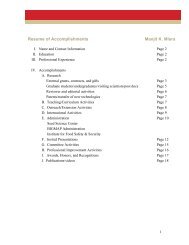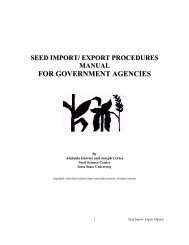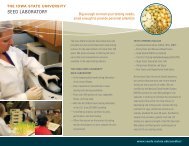Confined Production Processes for Non-Food Corn - Seed Science ...
Confined Production Processes for Non-Food Corn - Seed Science ...
Confined Production Processes for Non-Food Corn - Seed Science ...
Create successful ePaper yourself
Turn your PDF publications into a flip-book with our unique Google optimized e-Paper software.
CONFINED NURSERIESThe procedures that have been approved by APHIS <strong>for</strong>corn nurseries are the same as <strong>for</strong> all PMP production:• At any time during the field test when PMP plants areallowed to shed pollen, ensure that no other receptivecorn plants are grown within a radius of 1.0 mi(1.6 km) of the transgenic plants.• Where pollination of PMP plants is controlled, ensurethat transgenic corn is planted not less than 28 daysbe<strong>for</strong>e or 28 days after the planting dates of any othercorn that is growing within a zone extending from0.5 to 1.0 mi (0.8 to 1.6 km) of the transgenic plantsto ensure that there is no overlap in anthesis.• There are no other restrictions on corn that is grown atmore than 1 mi (>1.6 km) from the transgenic plants.These standards have been established using in<strong>for</strong>mationabout pollen number (Pohl, 1937; Ogden et al., 1974;Paterniani and Stort, 1974; Poehlman and Sleper, 1995;Coe et al., 1998), pollen size (Pohl, 1937; Funkhouserand Evitt, 1959), duration of pollen shed (Lauer, 1998),viability (Shoper et al. 1987; Luna et al., 2001), anddispersion. Because pollen size and mass have not changedsignificantly, distribution measurements done in the pastremain valid (Jones and Brooks, 1950; Wych, 1998;Di-Giovanni et al., 1995; Burris, 2001). Wind speedhas been verified as a factor (Raynor et al., 1972; Burris,2001). Theoretical work has been done on the maximumdistance of pollen flow (Raynor et al., 1972; Ireland et al.,2001; Luna et al., 2001). New in<strong>for</strong>mation and theoryare contributing to the validation of dispersion times(Fonseca, 2002). Recent research has been oriented onthe impact of transgenic pollen inflow in corn seedproduction (Ingram, 2000; Burris, 2001; Eastham andSweet, 2002).For nurseries, it is possible to envision additionalmeans beyond pollination control and isolation by whichoutcrossing and its consequential risk can be mitigated:• In hand-pollinated nurseries, internal non-PMPor -PMI border plantings may act as barriers anddiminish the concentration of PMP and PMI pollenemanating from the source.• Reduction in the number of transgenic PMP plantswithin the trial to diminish the concentration of PMPand PMI pollen at the source.• Reduction in the proportion of transgenic plants in thenursery to diminish the concentration of PMP andPMI pollen at the source.• Active daily surveillance by trained personnel of fieldduring flowering to ensure pollen control.• More comprehensive standard operating proceduresto minimize potential loss of pollen, plants, or seedsfrom confinement than could be implemented <strong>for</strong>larger fields.Such nursery procedures reflect the scientifically documentedinfluence of the size of the source (Ministère de l’Agricultureet de la Pêche, 2002) and borders (Jones and Brooks, 1950)on the rate of outcrossing in corn. Possible differencesbetween the nursery and large plot procedures andstandards reflect the influence size of the source as well asdifferences in borders, pollen control, and the concentrationof PMP or PMI pollen at the source.Multiple mechanisms contribute to the efficacy of borderrows within the field in reducing concentration of pollinationsin a receptor field. Border rows at the periphery of thetrial work partially because pollen grains on receptive silksare competitive and deteriorate with time after they arereleased. Pollen that has traveled further is older and lesslikely to compete well with younger pollen grains fromthe border and is less likely to effectively pollinate a kernelin a receptor field. The border also acts as a partial physicalbarrier. These effects reduce the level of PMP and PMIgrains in any corn that might be pollinated from insidethe perimeter border. Border rows also diminish theconcentration of PMP and PMI pollen at the source.Reductions in this concentration reduce the probability ofescape but may not prevent escape. Reduction can reducethe risk associated with escape of a hazardous PMP orPMI. If one assumes a fixed amount of PMP or PMIpollen escapes the field, increasing the amount ofnontransgenic pollen of similar viability moving with itwill reduce the concentration of PMP or PMI in the



